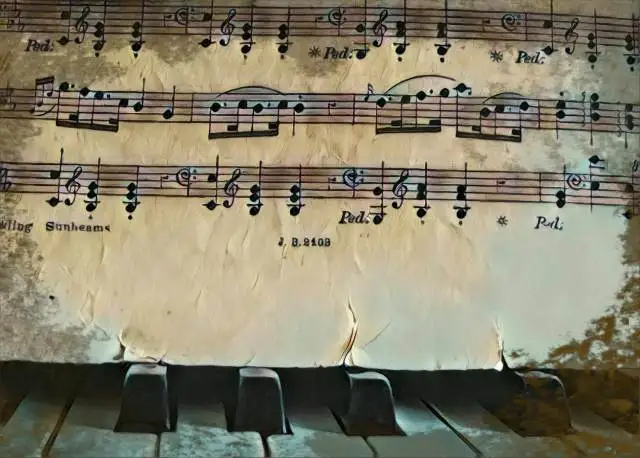Texture. The soft feel of your favorite t-shirt. The crispy-crunchy sensation of the last Girl Scout thin mint cookie disappearing in your mouth. In short, something you generally associate with tactile sensations.
So when someone talks about musical texture, it can lead to a spot of head-scratching. What is texture in music? How do you define it, and how do you talk about it? Why should you talk about it? Does Nickelback use texture?
All good questions. Let’s start at the very beginning.
What is Texture in Music?
Texture in music refers to the relationship between different musical elements of a piece. Texture adds depth, complexity, and richness to music.
A formal approach to describing texture would use a melodic line and the underlying harmony (or lack of it) to assess the musical texture, along with the rhythmic similarities or differences between them. This approach was developed as a way to analyze classical music (in all its forms), and doesn't really leave any room for describing texture created with modern music production techniques.
An informal approach would include other elements when considering the musical texture in a tune, such as form , tempo and timbre . This is particularly useful when you're talking about contemporary, or non-traditional music. For instance, you might describe Autechre's Gantz Gra f as 'granular', or TRXVELER's Treinamento De Força as 'sharp'.
With either approach, texture in music is all about how different elements work together to create a piece of music, influencing its mood, atmosphere and narrative.
Ways to Describe Texture in Music
It's a free world, and in the same way that a piece of music might convey different emotions to different people, musical textures may also be interpreted differently. Language is a funny old thing, and it's up to you how you decide to communicate.
But it's sometimes helpful to have a framework to work from. Which is where the formal approach of discussing musical texture comes in.
The following terms are often used in music history and music analysis to describe texture in music, and understanding texture this way can be beneficial to everyone. Be warned though; this methodology is heavily skewed towards 'Western' music. I'll rant more about this later...
For now, it's time to introduce the 'Phonys'!
Monophonic Texture
The first, and most simple musical texture is monophony. In monophonic music there is only one line of music. No harmony. No rhythmic accompaniment. No nothing.
It was all the rage back in the Middle Ages, when the earliest Christian songs - called plainchant - were about the only form of entertainment. Fun times.
A monophonic texture can be a solo voice/instrument, or multiple instruments playing the same thing at the same time.
Imagine you're at a Liverpool football match (soccer, for my US friends). You start singing You'll Never Walk Alone . That's a monophonic texture. But since it's only you, you might describe it as 'thin' or 'sparse'.
One by one, people around you start joining in. Because you and your cohorts are singing the same melody it's still a monophonic texture, but you might describe its texture as slightly thicker.
Eventually, the whole stadium is singing with you. It's still a monophonic texture, because you're all singing a single melody. But thanks to the varying timbres of the multiple voices you might also describe it as having a thick texture.
Below is a visual representation of a monophonic texture. The blue line represents a single melodic line.
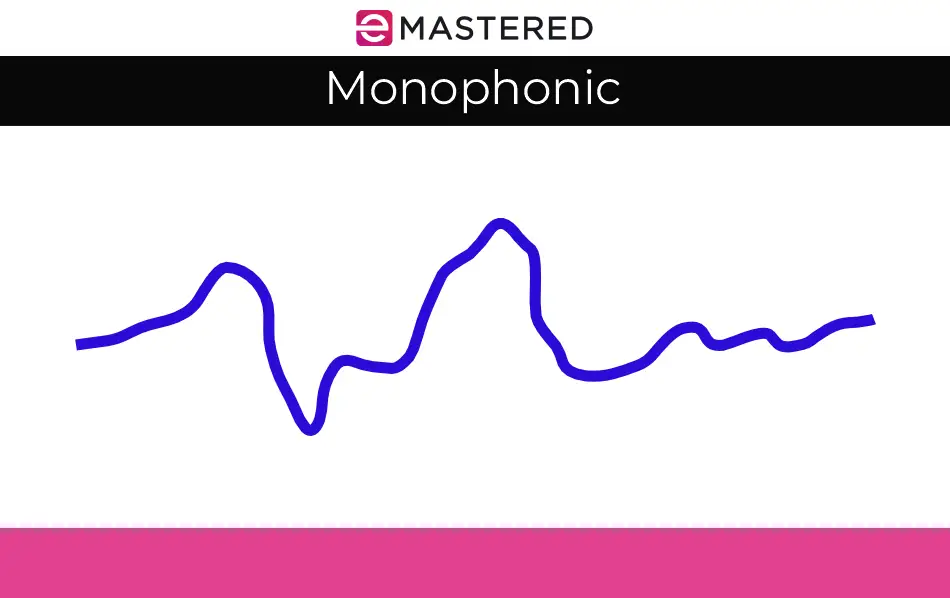
Homophonic Texture
The next step up on the texture complexity scale is homophonic texture. In homophonic music there is one distinct melodic line with all the other parts playing the role of harmonic accompaniment.
The graphic below shows a visual representation of a homophonic texture. The blue line representing the main musical line, with the green shading showing the harmonic support.
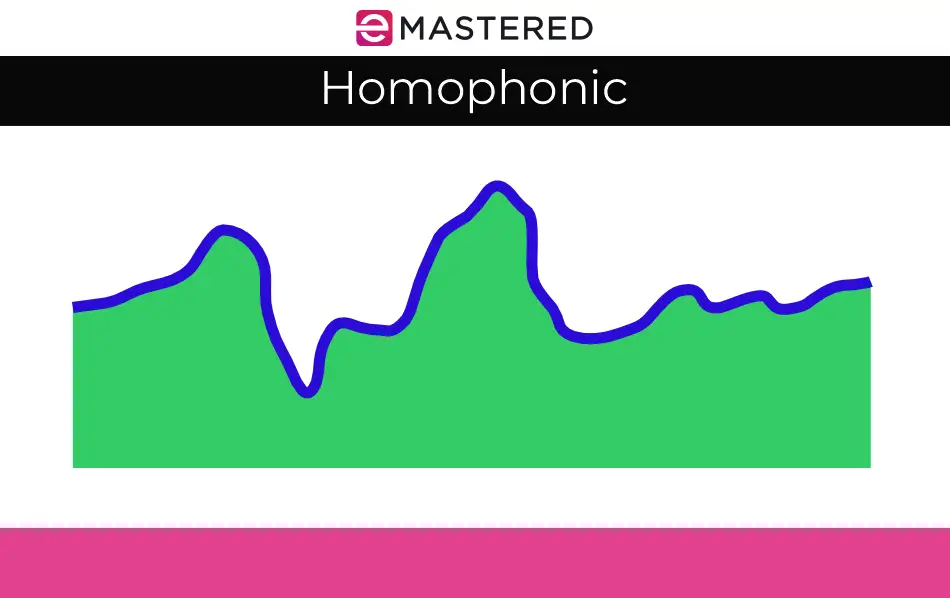
Most traditional protestant hymns and the music of a barbershop quartet are good examples of homophonic musical textures. There's nary a gospel tune that doesn't rely on homophony to raise the roof. In these examples, the different instruments or voices move together in block chords.
Traditionally in homophonic textures, all the instruments play the same rhythm - that of the melody line. But the term is often used more broadly to include parts that differ rhythmically from the main melody.
Think of a singer playing chordal accompaniment on a piano, or an accordion player playing a mournful melody with a guitar picking accompaniment in the background. Or perhaps a small jazz combo providing rhythmic and harmonic support to a trumpet improvising willy-nilly. Even though they're not performing the same melody, they are also not producing independent melodic parts. It's all just homophonic.
Because of this broader definition for describing homophonic music, it's considered to be the most commonly heard texture in music today.
Heterophonic Texture
This is a less common texture when you consider things on a broader scale, but worth taking a look at because of its uses on a more granular level.
In heterophonic music, multiple performers deliver variations of a single melody line. A singer accompanied by a single bugle sounding the same melody line with little riffs here and there would be heterophonic.
Going back to our Liverpool FC match (they're 2-0 up, so we're feeling bold). Everybody is singing along to the same tune. Suddenly, the north stand starts riffing on the long held note of 'a-loooone', much like when back up singers repeat the main hook while the lead vocal line ad libs. That, my friends, is a heterophonic texture.
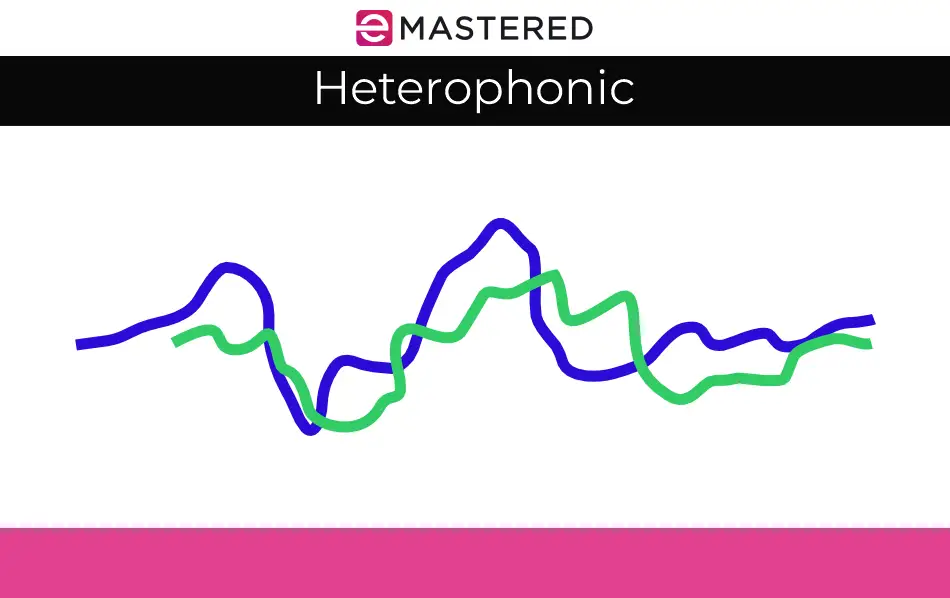
Polyphonic Texture
Polyphonic texture - taken from the Greek words poly (many) and phony (sounds) - is music made up of multiple parts with each playing an independent melodic line. All the constituent parts sound independent and have their own melodic interest, but they all work together to create an interesting (and harmonically sensible) texture.
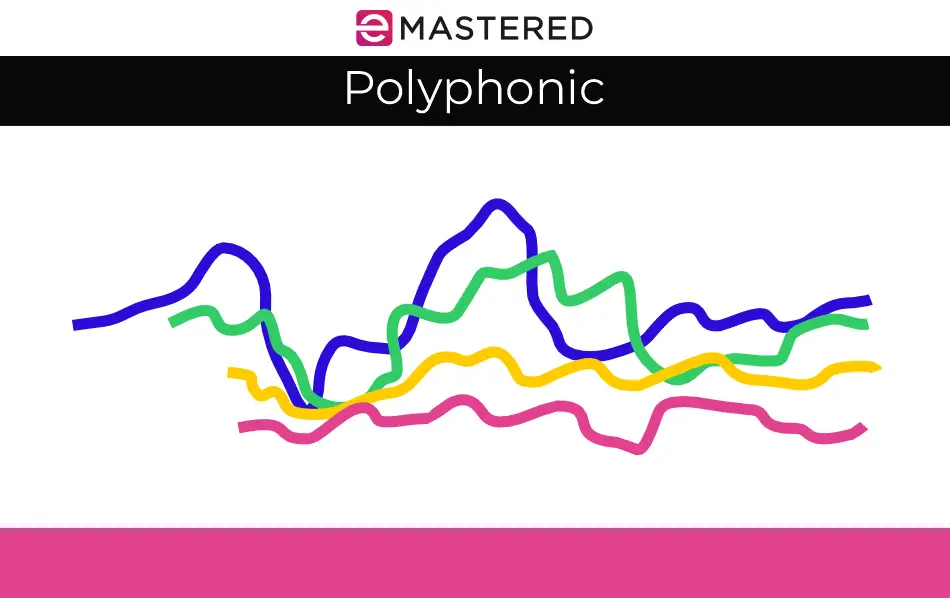
Polyphonic music, also called contrapuntal music or referred to as counterpoint, was predominant in the Baroque era. Bach's preludes and fugues are great examples of polyphony, and this style of writing music with different layers continues today.
Chris Rupp does a wonderful cover of Ed Sheeran's Shape of You, where he reimagines the song with the help of some well-written counterpoint. It's a great example of taking a homophonic texture and turning it into polyphonic music. Check it out below.
Note that in a polyphonic texture, each part will have an independent melody. This is different to one melody line with instrumental accompaniment, even if all the instruments are playing independent parts. The key difference is that in polyphonic texture each part functions as its own melody.
Why Is Musical Texture Important?
Aside from helping you have a deeper appreciation of the music you're listening to, understanding musical texture (from both a formal and informal approach) has many benefits:
Performance:
Musicians can do a better job of interpreting their roles in a piece of music when they understand the textures present. Particularly in large instrumental groups it's good to know whether you're providing back-up (homophony) , contributing to a melodic line (monophony or polyphony) , or providing embellishments (heterophony).
Composition
Understanding texture in music can be a great help when you're working on your own music. You can manipulate it to evoke specific emotions, or use it to draw out thematic elements. Want to be simple and direct? Monophony. Need to stress how complicated things are? Polyphony will be your friend.
Producing
As you piece together the elements of a track, think about the textures you're creating. Most music nowadays uses multiple textures in the same piece of music. How you present those textures will influence the story your song is telling, as well as how engaged your audience will be.
Mixing
Taking a moment to think about musical texture can help you solve problems and add creative effects when it comes to the mixing stage of a song.
Texture In Music: Formal vs Informal Approaches
Pick a song. Any song. Depending on which side of the academic fence you’re sitting on there’ll be two ways to talk about its musical texture.
The formal approach is to analyze the music through the lens of melodic lines, using the above categories. It’s a very useful tool for sure, and it's helpful in understanding how music works.
But it’s also highly elitist, and puts western music at the top of the food chain with little to no regard for cultures that have been cranking slammers out for eons. You might even look at it as a way for academics to justify their own existence.
The informal approach is to talk about musical textures by taking everything into account; melodic lines and underlying harmony, dynamics, the timbre of the instruments, the size of the ensemble, the rhythms involved, the complexity of the mix etc.
Both approaches are valid and helpful for understanding music, and knowing what you’re looking at can help you create better mixes , as well as help you as you write or produce a song.
Conclusion
So there you have it: everything you need to know about what is texture in music.
To recap, on an informal level you can use any word to describe texture. How you communicate is up to you.
But if your music professor asks you to describe texture in a Mozart piano concerto, you'd do well to take the formal approach:
- Monophonic texture: music where there is only one melody
- Homophonic texture: music with voices playing one melody and mostly the same rhythms. A broader definition includes rhythmic and harmonic accompaniment under the melody, such as strumming chords on a guitar.
- Polyphonic Texture: music with multiple, independent melodic lines.
- Heterophonic Texture: music where a melody is varied by an additional part at the same time as the original melody
Now go forth and maketh the textural music!


